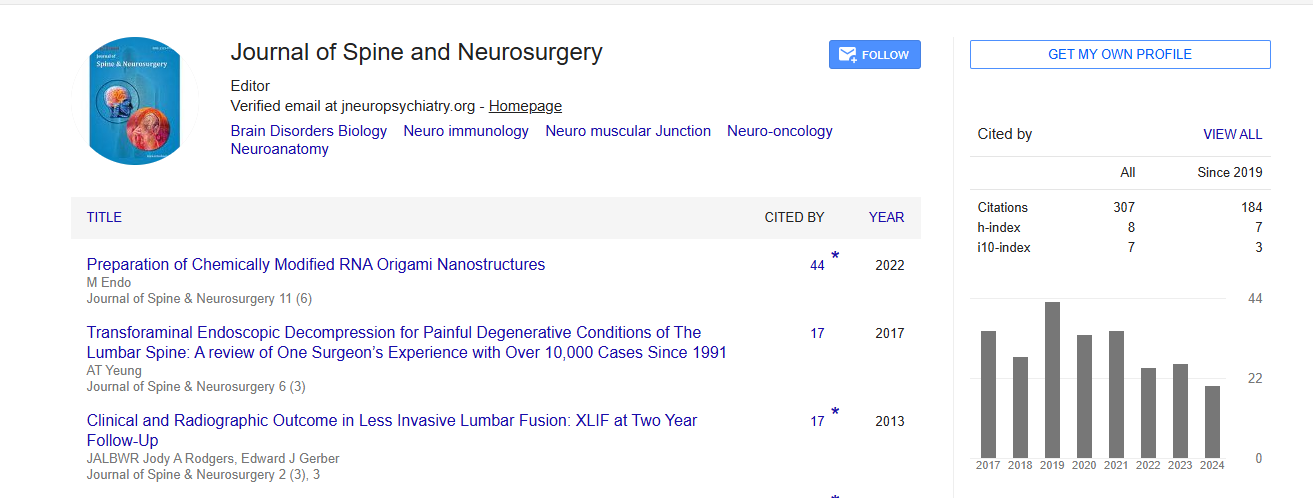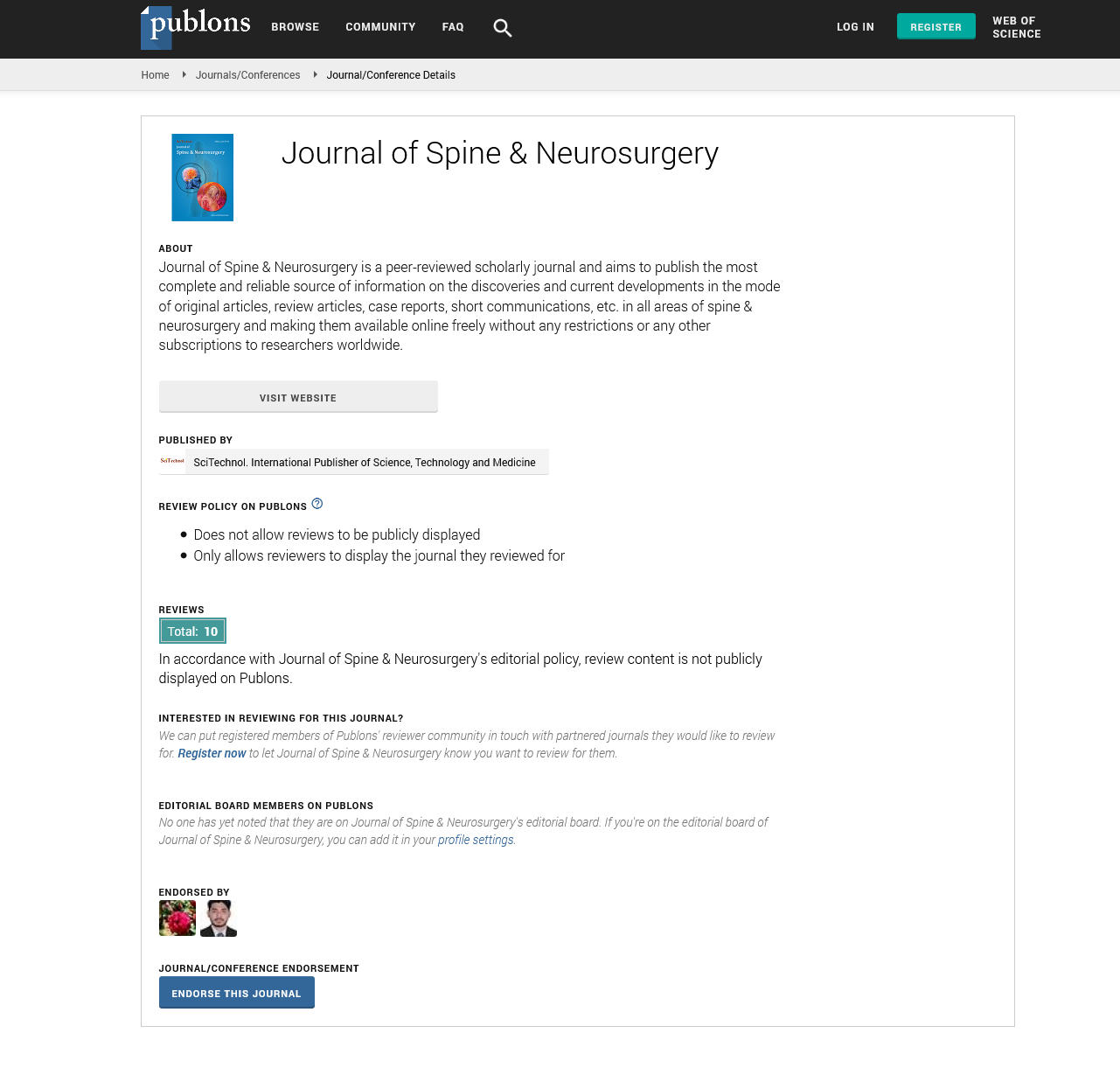Perspective, J Spine Neurosurg Vol: 13 Issue: 4
Nerve Root Compression: Insights into Causes, Symptoms, and Management Strategies
Description
The human spine is an engineering marvel, intricately designed to support the body, protect the spinal cord and enable movement. Spinal biomechanics, the study of the mechanical principles governing spine function, is a critical area of research in both clinical and engineering fields. Understanding the forces at work on the spine can enhance surgical outcomes, improve treatment strategies for spinal disorders, and lead to innovations in spinal implants and devices. This article explores the fundamental aspects of spinal biomechanics, its relevance to clinical practice and the implications for patient care.
The spine consists of 33 vertebrae organized into five distinct regions: cervical (neck), thoracic (mid-back), lumbar (lower back), sacral and coccygeal (tailbone). Each vertebra is separated by intervertebral discs, which function as shock absorbers, cushioning the vertebrae and facilitating motion between them. These discs are made of a gelatinous nucleus pulposus surrounded by a fibrous annulus fibrosus. The intervertebral discs, combined with facet joints and ligaments, allow the spine to bend, twist and rotate while maintaining structural integrity.
The biomechanical forces exerted on the spine include compression, tension, shear and torsion. These forces are generated through movements such as flexion, extension, lateral bending and axial rotation, as well as during everyday activities like walking, lifting and sitting. The ability of the spine to withstand and manage these forces is important for maintaining both function and stability. The natural curvature of the spine plays an important role in its biomechanics. The cervical and lumbar regions are lordotic, while the thoracic and sacral regions are kyphotic (curving outward). These curves allow for optimal load distribution across the vertebral column and play a role in shock absorption during physical activities. The curvature also enables the spine to adapt to dynamic postures, such as bending forward or twisting the torso, without causing excessive strain on the surrounding muscles and ligaments.
Disruptions in spinal curvature, such as in cases of scoliosis (abnormal lateral curvature) or hyperkyphosis (excessive outward curvature), can lead to biomechanical dysfunctions, contributing to pain, weakness and reduced mobility. Such deformities can place abnormal loads on certain areas of the spine, leading to disc degeneration, facet joint arthritis and even nerve impingement over time.
Spinal loading refers to the distribution of forces through the spine, which occurs during activities such as standing, walking, or lifting. When these forces exceed the spine's structural capacity, injury or damage can occur. Understanding how the spine handles loads is fundamental in developing treatment strategies for spinal disorders.
The spine is primarily loaded in the axial direction, meaning that weight is transmitted vertically from the head through the vertebrae and into the pelvis. This load is borne by the vertebral bodies and the intervertebral discs, which help distribute the pressure evenly. Lateral forces, such as those experienced during twisting motions, create shear forces that can strain the spinal structures, including ligaments and discs. Prolonged exposure to shear forces can accelerate the degeneration of spinal tissues. The spine's ability to bend or flex is governed by the interaction of muscles, ligaments and the discs between the vertebrae. For instance, when bending forward the anterior structures of the spine are compressed, while the posterior (back) structures are stretched.
Many spinal disorders can be understood in terms of biomechanical disruptions. For instance, herniated discs occur when the nucleus pulposus of an intervertebral disc pushes through the annulus fibrosus, often as a result of excessive loading or a traumatic event. This herniation can compress adjacent nerve roots, leading to pain, weakness, or numbness in the limbs.
Degenerative changes in the spine, such as spondylosis degeneration of the intervertebral discs and joints, can also be attributed to altered biomechanics. Repetitive stress and abnormal loading patterns, often due to poor posture, incorrect lifting techniques, or age-related changes, lead to degeneration of spinal tissues, loss of disc height and the formation of osteophytes (bone spurs). Spinal deformities like scoliosis or kyphosis can cause maladaptive changes in spinal biomechanics. In scoliosis, for instance, the abnormal lateral curvature alters the distribution of weight and pressure across the spine, increasing the risk of disc degeneration, joint pain and muscle fatigue.
Conclusion
Recent advancements in spinal biomechanics have led to significant innovations in the treatment of spinal disorders. For example, Minimally Invasive Spine Surgery (MISS) techniques have been trauma developed to reduce trauma to the surrounding tissues while addressing spinal deformities or disc herniations. These techniques rely on a better understanding of biomechanical principles to restore spinal stability with minimal disruption. In addition, the development of biomechanically optimized spinal implants, such as artificial discs and pedicle screws, has revolutionized spinal surgery. These devices are designed to restore normal motion and load distribution in the spine after conditions like disc herniation or vertebral fractures. Advanced Computer-Aided Design (CAD) and finite element modeling techniques allow for customized implants that match the unique anatomical and biomechanical characteristics of each patient. As technology advances, so too does our ability to analyze and intervene in spinal biomechanics, improving both the quality of life and outcomes for individuals suffering from spine-related issues.
Description
Nerve root compression is a prevalent neurological condition that occurs when a nerve root, emerging from the spinal cord, becomes pinched or irritated. This compression can lead to a variety of symptoms, including pain, numbness and weakness, particularly in the arms or legs, depending on the location of the affected nerve root. Understanding the causes, symptoms and treatment options for nerve root compression is essential for effective management and relief.
Several factors contribute to nerve root compression, with the most common being herniated discs, spinal stenosis, degenerative disc disease, bone spurs, injury or trauma and tumors. Herniated discs are often the leading cause of this condition. The intervertebral discs act as cushions between the vertebrae and when one of these discs bulges or ruptures, it can protrude into the spinal canal. This protrusion exerts pressure on nearby nerve roots, leading to symptoms. Herniated discs commonly occur in the lumbar (lower back) and cervical regions, where the spine is most mobile and subject to wear and tear.
Spinal stenosis involves the narrowing of the spinal canal, which can compress both the spinal cord and the nerve roots. This condition may develop due to age-related degeneration, arthritis, or congenital factors. As people age, the ligaments and tissues surrounding the spine may thicken, leading to reduced space for the nerves. Degenerative disc disease is another common cause of nerve root compression. As individuals age, the intervertebral discs lose hydration and elasticity, resulting in decreased disc height and potential nerve root compression. This degeneration can lead to instability in the spine, further exacerbating symptoms.
Bone spurs, or osteophytes, can develop in response to arthritis. These overgrowths of bone can protrude into the spinal canal or foramina the openings where nerves exit the spine, causing compression. The presence of bone spurs is often associated with conditions like osteoarthritis and can significantly contribute to nerve root compression. Injury or trauma can also result in nerve root compression. Accidents or falls that cause fractures or dislocations in the spine can lead to immediate and significant compression of nerve roots. Additionally, tumors, whether benign or malignant, can occupy space within the spinal canal or foramina, leading to nerve root compression.
Symptoms of Nerve Root Compression
The symptoms of nerve root compression can vary significantly depending on the location and severity of the compression. Commonly reported symptoms include pain, which is often sharp, shooting, or burning in nature and may radiate along the path of the affected nerve; for example, compression in the cervical spine can cause pain that extends down the arm, while lumbar spine compression may lead to pain radiating down the leg, commonly known as sciatica. Patients may also experience numbness and tingling, often described as a "pins and needles" sensation in areas supplied by the affected nerve, which can be particularly distressing and may indicate ongoing nerve irritation. Additionally, muscle weakness in the affected area can impede the ability to perform certain movements, with individuals experiencing lumbar nerve root compression struggling to lift their foot or toes, resulting in a condition referred to as "foot drop." Reflex changes, such as diminished or absent reflexes in the affected area, may also occur, prompting healthcare providers to assess reflexes during physical examinations to gauge the extent of nerve involvement.
Diagnosis and treatment options
A thorough clinical evaluation is essential for diagnosing nerve root compression. Healthcare providers will often conduct a physical examination to assess symptoms and neurological function. Imaging studies such as Magnetic Resonance Imaging (MRI) or Computed Tomography (CT) scans are typically employed to visualize the spine and identify the source of compression. These imaging techniques can help determine the extent of the problem and guide treatment options. Treatment for nerve root compression aims to relieve symptoms, restore function and address the underlying cause of compression. Many cases of nerve root compression can be effectively managed through conservative measures before considering surgery. Nonsurgical options typically include physical therapy, where targeted exercises and stretches are designed to strengthen the muscles surrounding the spine, enhance flexibility and alleviate pressure on the affected nerve.
A physical therapist can create a personalized program focusing on restoring strength and function. Additionally, medications such as Nonsteroidal Anti-Inflammatory Drugs (NSAIDs), corticosteroids and analgesics may be prescribed to reduce inflammation and relieve pain, with oral corticosteroids sometimes utilized to decrease swelling around the nerve root. Epidural steroid injections can also provide temporary relief by delivering corticosteroids directly into the epidural space, helping to reduce inflammation and improve mobility. If conservative approaches do not alleviate symptoms or if the compression is severe, surgical interventions may be considered. Surgical options include discectomy, which involves the removal of the herniated portion of a disc to relieve pressure on the nerve root, as well as laminectomy, which removes a portion of the vertebra to create more space in the spinal canal. Foraminotomy, another surgical option, expands the foramina to relieve pressure on the nerve roots and may be performed alongside other procedures.
Conclusion
Nerve root compression is a significant medical issue that can severely impact an individual's quality of life. By understanding its causes, symptoms and treatment options, patients can seek timely intervention and appropriate care. Early diagnosis and intervention can lead to better outcomes, helping individuals return to their daily activities with reduced pain and improved function. If you suspect you may be experiencing symptoms of nerve root compression, consult a healthcare provider for a thorough evaluation and personalized treatment plan.
 Spanish
Spanish  Chinese
Chinese  Russian
Russian  German
German  French
French  Japanese
Japanese  Portuguese
Portuguese  Hindi
Hindi 
